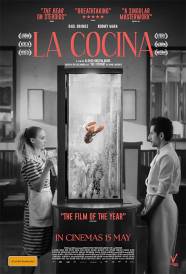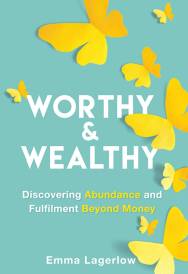Jim Loach Oranges and Sunshine Crew Interviews
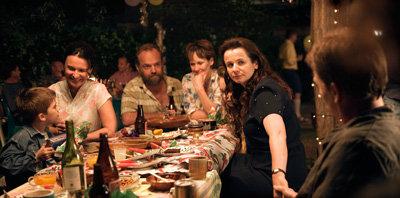
Oranges and Sunshine Crew Interviews
Cast: David Wenham, Emily Watson, Hugo WeavingDirector: Jim Loach
Genre: Drama
Rated: M
Running Time: 105 minutes
Synopsis: The story of Margaret Humphreys (Emily Watson), a social worker from Nottingham, who uncovered one of the most significant social scandals in recent times: the organised deportation of children from the UK to Australia during the 40s and 50s, some without their parent's knowledge.
Almost single-handedly, against overwhelming odds and with little regard for her own wellbeing, Margaret reunited thousands of families, brought authorities to account and worldwide attention to an extraordinary miscarriage of justice.
Oranges and SunshineRelease Date: June 9th, 2011
Interview with Jim Loach, Director
Question: How did this film come about?Jim Loach: I first met Margaret in 2002. I'd read her book and there'd been one or two small bits in the newspapers in Britain, but not much. Margaret's got a small office above a café in Nottingham so I went up to see her. At the time I was thinking about a documentary but I wasn't sure how I could approach it. We just sat there and chatted and at first I think she gave me fairly short thrift to be honest, but we warmed to each other. I stayed in touch with her over the next couple of years and got to know her better. And it was during that process I started to think that her own journey through the whole thing was a way of tackling it as a drama because she started to just speak more about her own experiences.
Camilla Bray, Producer and I met Rona Munro, Writer in 2005 and a few months later Rona Munro and I came out to Perth and met Margaret again. We spent a couple of weeks with her and also some time with two particular former child migrants. It was really during that first trip that we started to see how we could build the story and the narrative - how we could find our way through the material because we had a sense it was a great story to tell, but of course it was about how are you going to tell it. Rona Munro especially spent a lot of time with some of the real former child migrants and heard a lot of their stories, so she had a wealth of material to go on. But we didn't have a script at that stage, just lots of ideas and text messages.
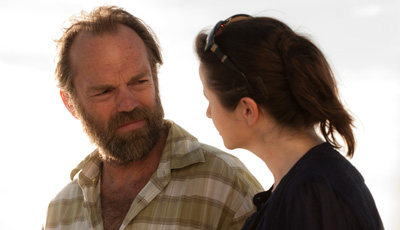 Question: How did the script evolve?
Question: How did the script evolve?Jim Loach: Right at the outset we had a sense of how we were going to approach it: it was very much Margaret's story. It was going to be Margaret the character and seen through her eyes. So then Rona Munro locked herself away and started to write.
Question: What did the script development process involve?
Jim Loach: Well we were trying to simplify it and boil it down because we never really wanted to make it a campaigning film. We were interested in exploring the nature of identity and what makes us who we are - and if you take all those things away from somebody how do they come to terms with it? It was also quite a challenging scripting process because of course the real events happened over a very long period of time, so we had to find a way of shaping it into a coherent, singular narrative. It was one of those stories that you could go spinning off into all sorts of different areas - you could look at the involvement of the Catholic Church, or you could look at the role of the state in caring for so-called less privileged people. We had to home in on our story.
Question: How did Emily Watson come to be cast as Margaret?
Jim Loach: Emily Watson was top of our list right from the really early days and once we'd got to draft five or six we got in touch. Emily Watson had just had her second child when we first met a couple of years ago. It was on the day that London ground to a halt with snow and so it was quite memorable. I trudged over the river and we sat in a café drinking hot chocolate and spent about four hours looking at it from all sorts of different angles. From that moment she was really committed to it.
Question: Why was she top of your list?
Jim Loach: Obviously there was all the basic stuff: she's the right sort of age and she has children. But I just fundamentally felt that I could believe her as a social worker. For an actor of a certain stature, it's a challenge to put them in a tower block in Nottingham and to really believe it.
Question: Was it a conscious decision not to portray your two main child migrants as victims
Jim Loach: Definitely. The guy that became the inspiration for the Len character is just an absolutely fantastic man and the reason that Rona Munro in particular was really attracted to his story was that he was emphatically not a victim. If you described him as a victim or even if you offered him sympathy as a person, he would tell you to F off! He's just not interested in being that person and we found that in a way much more appealing to write - much more complex. We really wanted to avoid victimhood, because that wasn't our experience of the child migrants that we met. They've got an amazing dignity and strength about them, they really have and they don't strike you as victims.
Question: What was it like when the government apologies were issued in the middle of your shoot?
Jim Loach: It was just the most bizarre bit of timing because it was a project that we'd been working on for years and years. For it all to happen at the same time was really strange.
Question: What about for Margaret? Were the apologies vindication for her?
Jim Loach: She's not someone that would allow herself to be congratulated. She just doesn't think in those terms. She puts herself bottom of the list - she'd kill me for saying that, but she does - and so you didn't get the feeling there was any sort of triumphant moment for her - although in some ways it should have been.
Question: As someone who has a background in documentaries, what does a drama add to this story that straight documentary couldn't?
Jim Loach: Documentary can expose the facts and point the finger and bring people to account. But I think a drama can explore the themes in a much more interesting, human way - themes such as identity and the role of the church. For me it's a more rounded way of looking at it.
Question: It's your first feature film, and you chose to shoot it on opposite sides of the world. What problems had to be overcome?
Jim Loach: When you start these things you just don't really think of it in terms of the practicalities. Maybe I should have done! The biggest challenge I think was that when you're in the UK you focus on the stuff in this country and the Australian element seems so far away. It meant the Australian element could become quite unreal. And then somebody in Australia would have the same problem about the UK. We really didn't want to have a film with a split personality, so we put a lot of work in to trying to make it coherent in that respect.
Question: As a first-time feature film director, what are the upsides and downsides of having the surname Loach?
Jim Loach: God. How do I answer this one? Well I don't know, that's been quite a big journey for me I think and it's a real challenge. In many ways of course it's the classic double-edged sword, but you just have to put to one side what you understand the perception to be because you just can't do anything about it. So now I just get on with it, though I wouldn't say it's beneficial. But my Dad is the first person I talk to about things and we talk about every aspect of filmmaking all the time. That part of it is great. But he's just my Dad.
Interview with Rona Munro, Writer
Question: What was it about this story that grabbed you?Rona Munro: In some ways I almost didn't want to do it because I did Ladybird Ladybird with Ken Loach years and years ago and because that's a true story of a woman having children ripped away from her I get offered an awful lot of true stories about women having children ripped away from them. While a lot of them are really, really worth telling there's that thing of you just don't want to keep telling that story. So in a way I was quite resistant to it. What sold it to me I think was the fact it was such an incredible story - and nobody knew it. Also it was not a story about people feeling sorry for themselves or people who saw themselves as victims; it was very much a story about survivors. Over and above that there was the moral question that Margaret's very existence presents because she was a very ordinary person basically getting on with her job and then this story landed on her. I don't think she ever had any doubt that she had to do what she had to do - just keep trying to get help to these people and bring their story out. Most of us might not even have engaged, and I think that was why I found her character fascinating!
Question: What contact did you have with Margaret?
Rona Munro: Well I met her, which was great and I think we had about six or seven sessions together in the end. I would travel up to Nottingham, sit and talk to her for however long she had and work through her take on things.
Question: How closely did you follow Margaret's book?
Rona Munro: I think film can probably only tell one story; books can tell about seven or eight, but in film you've got to decide what's your main story and just tell that. Quite early on we had decided we wanted to tell the story from one person's point of view and it should be Margaret's. So then it was about which of these myriad stories that were recorded in the book and all the other stories of the child migrants and what they'd been through and their back story� which of those do you then include to tell your main story? It was really about amalgamating and cutting and trying to keep finding what are the things that are the emotional core of this that'll actually play for an audience? And of course, when it's a true story you end up going, 'That means that this woman's tale is never going to get told.' You almost feel like you're letting people down because you can't put everybody in. We could have made about 18 films out of what was there.
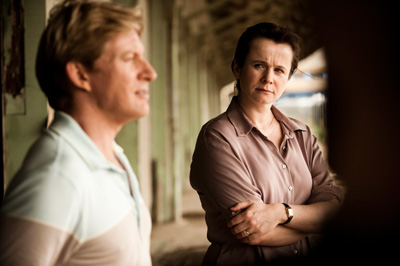 Question: What sort of things did you learn about Margaret from your sessions with her that you couldn't have gleaned from the book?
Question: What sort of things did you learn about Margaret from your sessions with her that you couldn't have gleaned from the book?Rona Munro: She's a lot funnier than comes over in the book. She's a very attractive person in every sense: to look at as well as how she comes across. She's also really quite emotional. In the book and whenever we saw her dealing professionally with child migrants she's so level and so calm that there's always the worry that the audience are going to think, 'This woman's not feeling anything,' because she's so good at being a neutral receptacle for everyone else's emotions. But she herself is actually very emotional and that was a very useful thing to find out. It made my job a lot easier.
Question: To what extent is your script factually accurate?
Rona Munro: It's the sort of thing that sometimes people get very irate about, especially when you're asking them to care about something and distressing them. In terms of the facts there's nothing in the film that raised a question legally, otherwise it wouldn't be in the film. In terms of what characters did and said I saw my job as trying to decide what's the emotional truth. In other words, how would that character want themselves to be represented and what should we as an audience understand about where they are emotionally in this moment? You can't possibly answer a huge question like that by talking to someone for a few hours, but as far as I could I thought that was my responsibility: to make sure that it was emotionally truthful so that those characters would go, 'Yes, I recognise that. That is my truth as I understand it.'
Question: Is this still a live issue or has some sort of closure been achieved for the people involved?
Rona Munro: For a lot of the migrants there's never going to be closure because there's never anything adequate - which is again something I think we've tried to inject into the film. I certainly think there's still bad feeling on both sides. We obviously went up to Bindoon and though there was no sense of our way being barred from both the people taking us round and the very kind of peripheral encounters we had with people there, there's a real wariness. This is basically an open wound.
Question: It is a startling story and one of the most startling things about it is that it isn't widely known. Did that surprise you?
Rona Munro: Very much so. The apology happened just as we were in the middle of filming and yet how long had Margaret been trying to get that? That's a whole other film again about her battle with successive governments and successive Home Secretaries. It's like a series of British governments have basically hoped this would go away.
Question: What do you think is at the crux of this film?
Rona Munro: It's the moral question that someone like Margaret asks all of us: if you notice that something's wrong, how much are you prepared to do about it? And then there's the actual story of the child migrants and the fact that they can never have adequate restitution. But even over and above that was how easily it happened. You kind of think, well if that was happening then what's happening now, and what has happened throughout world history? I think what we all realised looking at this story, is if you take a child away from its sense of family and its sense of country and sense of self, that's an injury over and above any abuse.
Question: You've worked with both Jim Loach and Ken Loach. You're one of the few people who can compare�
Rona Munro: The similarities are they both know what they want, very clearly. They both communicate that in such a democratic, gentle, laidback, unconfrontational way that you aren't even aware you're being persuaded of someone's very steely vision of what should happen. Yet they both have a rock hard idea of the film they want to make.
Interview with Camilla Bray, Producer
Question: How did you go about financing the film?Camilla Bray: We had been developing the project since 2005, and by 2008 I made my first trip to Australia and we were sending the script out to cast. Because it was such an Australian/British story with Margaret travelling between the two countries we knew from the outset that we were going to make it as a co-production. So the key thing for me really early on was making contacts with people in the Australian industry: key talent that we would need in order to put together a really strong package for financing, making contact with Screen Australia, talking to the regional agencies there to try and work out where to shoot the film, and meeting distributors. The fundamental issue for me was finding the right co-producer. Most of all making a film on the other side of the world you know you're going to need a really solid partner to fight your corner for you. So finding Emile Sherman at See-Saw as our co-producer was crucial. We put together a pretty complex financing structure involving national tax incentives, regional funding in both the UK and Australia, private equity, pre-sales, gap, and equity investment from Screen Australia so having us both working on it round the clock was a huge advantage if rather exhausting.
Question: What are the complexities of working on a real life story where the real character is in contact with you?
Camilla Bray: The relationship has to be based on trust. Jim Loach is brilliant at that; he's the key to the relationship with Margaret and the child migrants that we have met, and who have helped with research both behind and in front of camera.
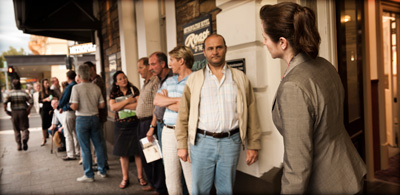 Question: What was Margaret's involvement in the actual filming?
Question: What was Margaret's involvement in the actual filming?Camilla Bray: We showed Margaret all the scripts but she didn't come to the shoot and she didn't meet Emily Watson. I think that was probably a good idea because it just meant that we could make the film and Margaret could have some distance. She has seen the film, and is hugely supportive, so her input when the film comes out will be invaluable. Margaret has been through a huge amount not least over the last couple of years with both governments apologising, so she was working flat out for the Child Migrants while we were filming.
Question: How do you go about getting actors of the calibre of Emily Watson or Hugo Weaving on a film which has a comparatively low budget?
Camilla Bray: We had a beautiful script from Rona Munro which is a good place to start. The fact that this story is true, and is so shocking, makes people want to get it told. It also helps that Sixteen Films and See-Saw Films have between them made a few films so the actors feel like there's a chance it might actually happen. After meetings between Jim Loach and the actors the challenge was to keep everyone on board while we jumped through endless financing hoops.
Question: What are the complexities of trying to produce a film on two different continents?
Camilla Bray: Getting money for an independent film is always going to be incredibly tough, but for this project the logistics were also daunting. We assembled our core team early on so that we could get as much in place before the production swung into action. Before the pre-production started we had the bulk of our cast in place, we knew pretty much our key locations and had done early work with the designer. The challenge was then budgetary as we had an unusually long production period for a film of this scale - about four months - because we had a split shoot first in the UK and then in Australia. But we had terrific support from all our cast and crew which made it do-able.
Question: What it was like when you heard that the Australian and UK governments would be formally apologising?
Camilla Bray: When you've got both Australian and UK Prime Ministers standing up in parliament apologising and acknowledging what took place, that ends the discussion of, 'is this exaggerated, aren't you maybe enhancing one or two bad incidents in order to have a story?' We met that disbelief, implied or overt, when we were putting the film together, so I can't imagine how hard it must have been for the child migrants to encounter that attitude for all those years.
Interview with Emile Sherman, Producer
Question: How did you become involved in the project?Emile Sherman: I met Camilla Bray, Producer briefly in Cannes two years ago when she'd been developing this project and was looking for an Australian producer to work with. Then she came out to Australia, and I met her again there. My focus in terms of producing has always been looking for material that's meaningful and that's interesting and will be of interest to audiences in the UK, Australia and internationally. This wasn't a big film in terms of budget but it really fits the bill in terms of being a hugely significant and meaningful story. And also one that we feel will resonate, both in Australia, UK and around the world. It's a story which has triumph of human sprit elements but also is very realistic in its portrayal of the challenges of trying to take on a system and right the wrongs of the past. That sort of story with that sort of balance is something we were interested in. We want to tell stories that are going to have an impact and we think this one will.
Question: What has your involvement been?
Emile Sherman: This was one of the few absolutely genuine 50/50 co-productions in terms of its creative heart. It's a true UK/Australian story. I remember very clearly having read the script for the second time and coming home to talk to my wife. We had just had a baby at the time and we were discussing whether or not we should get involved in this film. My heart so clearly told me that this is a meaningful story - the script was just hugely affecting. I kept crying whenever I read it but in a really satisfying way, because it was touching as well as being painful. There are very few scripts you read to which you react so viscerally. It's been the same for me throughout the whole production process - watching the rushes, being on set, watching the cuts. The real moments of human contact and of hope and disappointment just weave their way through the script and the film. They come from a place of truth, they don't feel manufactured and that's really what made me passionate about being involved in the project.
Question: How did you go about finding cast and crew in Australia?
Emile Sherman: Jim Loach hadn't worked in Australia before. He came over here, I drew up lists of top four DOPs and Production Designers and Casting Directors and Sound Designers - various people who I've worked with before and think are great - and we organised for Jim Loach to meet with them. He ended up having really top bonding with them.
Question: How did you go about financing the film?
Emile Sherman: A lot of the money came from the Australian side. I worked very hard with Camilla Bray for many months to bring the finance in. As a co-production it adds to the challenges of financing a film because there are a number of complexities involving many rules and additional contracts. We had more parties involved in financing this film than I've ever dealt with previously. I think there were 14 names on the inter-party agreement and this was on a relatively small-budget film. With the time zones we ended up having calls here at 7 and 8 pm for two hours every single night for three weeks! It was just a mammoth effort to get it over the line. But the benefit of co-productions is that you're treated as a local production in both countries so we were able to access funding in the UK and in Australia as if we were both a UK and an Australian film. You always climb Everest to get a film financed. But to do it knowing that the subject matter is so compelling and significant makes it worthwhile. At the very least you know that it's a meaningful journey, rather than just a journey.
Question: How was the Australian section of the shoot?
Emile Sherman: The majority of the shoot was done in Australia. Jim Loach and Camilla Bray are the most gentle, calm and lovely people you're likely to come across and so the tone of the whole production fed down from them - it really was a very pleasant environment for everyone to work in. With the subject matter and the cast, everybody just embraced the warmth of the production and hopefully that comes through the movie. We shot in South Australia in Adelaide, and ended up using quite a lot of Adelaide crew and supporting cast as well. It's a great place to shoot films, very easy, because it's smaller than Sydney, they're very friendly towards film productions, it's less expensive, there are varied locations and they make a number of movies there - I've done probably four or five films in South Australia now. A lot of the story is set in Perth, but when we were discussing where we should shoot it I felt South Australia was the best place because the film is set in the 80s so we couldn't just go to Perth now. That wouldn't look right. Adelaide felt like it was going to be the best environment to be able to capture the time - there are probably fewer absolutely new buildings or skyscrapers there but it's still a significantly sized city with lots of federation-style buildings, which we were looking for. That combined with the crews there, and the fact that the South Australia Film Corporation provided some good support for us in terms of equity investment made it the right place.
Question: Will this film be controversial in Australia?
Emile Sherman: I think the overarching feeling now that the apology has happened is that we need to recognise the enormous harm done by the child migrant programme. At the same time there were some different experiences of it - not everybody had a horrific time. So there may be criticisms from certain groups that it wasn't all bad. But there's no doubt that it's accepted that the programme created a huge amount of lasting negative effects, and I think our film captures those effects pretty faithfully.
Interview with Denson Baker, Director of Photography
Question: What were your initial thoughts on the style of the film?Denson Baker: When Jim Loach and I first started talking about the film and the approach to it, the look of it, we knew that we wanted it to be something which was based in realism. We wanted it to start as an intimate story about this woman who's living her life and then gets launched on this whole involuntary hero's journey, so the film starts to get bigger and more epic as she starts to get embroiled in what we saw as a detective story. So at times we have a bit more of a documentary feel: there's a lot of shooting off the shoulder, a lot of handheld in there. But at other times it'll be more epic, with the occasional crane shot or a little dolly shot. That really takes the audience into the scene and lets them know they're going on a big screen journey.
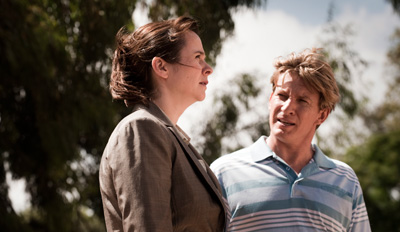 Question: Did you shoot on film?
Question: Did you shoot on film?Denson Baker: Yes. Jim Loach and I had a lot of discussions about what format we should shoot the film on and both he and I were really adamant about wanting to shoot on 35mm film as opposed to going digital like a lot of films these days. There are a couple of reasons: one of them was that it's a film set in the 80s - we wanted to shoot on a format that was shot on in the 80s. But we also wanted it to be a cinematic film and we felt that 35mm really does do that. Plus, we just found our style of working was much more suited to the film conventions which leave the camera free to roam. I've found on digital productions that you end up with this big mothership that follows you everywhere, this big base of cables and recording decks and laptops. That wasn't suitable for what we wanted to do.
Question: How did you distinguish between the two countries in the look of the film?
Denson Baker: We shot in Nottingham in winter. There we wanted to have a colder feel, wanted it to feel a little bit more atmospheric. And then Margaret arrives in Australia and its hot, scorching sun. It's brighter. It's kind of vibrant, but then you start to realise that it's not all oranges and sunshine: there's something sinister going on in a way, so we wanted the look to be bright, but not all saturated - it's not all happy. Generally we chose to backlight our characters and shoot into the shadows, so as to have it look a little bit more scorching than comfortable.
Question: How was working with Jim Loach?
Denson Baker: He's a great director. He really knows what he wants and he's also someone who's very quick to make a suggestion that can change the scene and turn it into something that bit better. We've liked the idea of doing a lot of it off the shoulder; let the actors play the whole scene through, shoot it in one shot, just a few takes. We wanted often to have that sense of 'here it is happening before our eyes', without having to resort to cutting up a scene. A lot of the film is one-shot scenes.
Question: Did you ever have two cameras?
Denson Baker: Only on a couple of occasions. In the barbecue scene we had two shooting simultaneously, but the idea there is that we can create the environment, allow the scene to play out and have two cameras capturing as much of it as we can within the one take. We wanted to create the feel for the audience that you're within it, so we're often making lens choices to put the cameras within the scene rather than just observing the scenes.
Question: What was the greatest challenge you faced on this film?
Denson Baker: I think the greatest challenge of a cinematographer is more than just capturing an image, but capturing a feeling, an emotion and telling a story. The cinematographer's the first audience in a way. You're looking at the shot as it happens and you want the feelings that you have while watching that scene to be the same feelings that the audience will have when they're sitting in the darkened cinema in a few months' time.
Interview with Melinda Doring, Production Designer
Question: What was your original brief?Melinda Doring: Jim Loach didn't want anything to distract you from the storytelling - that was the main brief.
Even though it is a period piece in that it's set in the 80s and even though things looked different then - no mobile phones, no laptop computers, different cars - he really wanted to make sure that the period didn't overtake the storytelling. So we talked a lot about how we were going to approach the piece so that it had references to the period, but you weren't overwhelmed by it. The main thing was talking to Cappi Ireland, Costume Designer and Denson Baker, DOP about reducing the colour palettes. We decided we'd just have this approach to the film that was subtle, not in your face. Jim Loach's got this real thing against red so we avoided that and went for really subtle tones.
Question: What research did you do?
Melinda Doring: Margaret Humphreys' book Empty Cradles has been an amazing resource. There's so much detail in the way she writes. She actually describes spaces and places, people that she's met, so that was fantastic. I also looked at documentary photos and 80s photographers for real life images that are evocative of that period, and did a lot of research into Bindoon itself which is where a lot of the story takes place. Also, in our research my set decorator Glen Johnson got to go to the Melbourne Migrants Trust and he got a real feeling of how those places operate. He got to talk to some of the child migrants there and that gave us a real insight into the real people behind the story.
Question: What research did you do in the UK?
Melinda Doring: I visited Nottingham where Margaret comes from. I didn't get to meet Margaret, but you get a real feeling of what Nottingham is as a city and how it contrasts to Australia. We were always trying to look for how we could contrast the UK and Australia in the storytelling, because the film flips backwards and forwards between the two countries so much. We really wanted to show that contrast. I had an art department in the UK and they'd give me reference points - because we had to have lots of 80s packaging in the kitchen and of course it's all local brands that I'd never heard of before, so they made sure that all of those details were right.
Question: How did you recreate Bindoon?
Melinda Doring: We couldn't film in the real location in Western Australia so we had to piece together lots of different locations. The main building was a Masonic Hall. We've used the exterior of Glenside Hospital as the front of Bindoon and we built things out at Arkaroola.
Question: What props did you have to recreate from the period?
Melinda Doring: Whenever you read a script there are often props references, that's what actors touch and deal with, but it's not until you start researching it and you're trying to work out how we're going to make this that it gets interesting. We had to find all these photos because there are a lot of scenes of Margaret looking at pictures of child migrants, so investigating all of that was really interesting. We got to see all these photos of these kids lined up, waiting to go on ships to Australia and then arriving in Australia - some of them are so heartbreaking. There are theses incredible pictures of little boys in these coats that are way too big for them that have all been roughly pinned up to make them all look neat. And one of the stories was that this was often done just for a photo-shoot. Then the coats were taken off them because they weren't actually theirs: it was all part of making it look like the authorities were doing the right things by these kids, like a publicity campaign really.
Interview with Cappi Ireland, Costume Designer
Question: What attracted you to the project?Cappi Ireland: Several things - that it was a true story and a story that had to be told. Also, I wanted to have that whole experience with the UK side of things, and it was also period so that's always really a big plus for a costume designer. Even though we're not sort of going full on with the period, it's still just nice to tap into.
Question: What was your original brief?
Cappi Ireland: We had a lot of materials to work with in the sense that it was based on a true story. So we've had complete access to a lot of images of the real characters and what happened over the course of the story of the film. For Jim Loach I think he really wanted to keep it realistic. We didn't go very full on with the period, because we wanted to keep the characters as real people. We're not dealing with high-fashion kind of characters in this film. They're all very ordinary people who've had very ordinary - and yet extraordinary - lives, but their demographic is pretty much normal. I guess Len's probably an exception to the rule because he's the more glamorous of the characters, but we wanted to focus more on the emotions and the story rather than doing a big 80s sort of fashion festival. We also kept the colour scheme very subtle and very muted to try and keep in line with the emotion of the film, never having anything too bright and busy that would detract from the story.
Question: What look were you after with Margaret?
Cappi Ireland: The look for the first part of the film in Nottingham was a working class environment with Margaret Humphreys as a social worker doing her best to get her job done. It was supposed to be quite bleak: the UK in winter is bleak. The colours are very flat and very grey and we really sort of wanted to play that up a bit, because then when we come to Australia it's a completely different story. There it's completely bright and sunny and the horizons are huge compared to the UK. So when we were buying the costumes we kept in mind that we should have a difference between the two. The important thing is Margaret cares about what she's wearing, but she is there to do a job. She puts her suit on, and it's almost like a suit of armour.
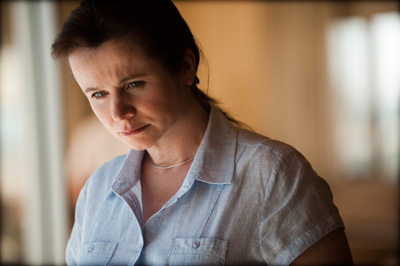 Question: Does Margaret's look change as the film progresses?
Question: Does Margaret's look change as the film progresses?Cappi Ireland: It changes according to season, but her general silhouette is always the same. She's always very well turned out - although she can look shabby when she needs to look shabby - but as far as her clothes go she's always quite well appointed. She's a fairly conservative dresser. We're not talking t-shirts and shorts; it was always a skirt and a blouse and most often a suit where possible. When she came to Australia though, we wanted to place her in a bit of a fish out of water scenario - she's an English rose in this rugged environment and heat and even when she's heading off to Bindoon, a pretty harsh landscape, we wanted to keep her in a suit. She looks quite out of place which was a deliberate decision that Jim Loach and I made, and Emily too.
Question: What research did you carry out?
Cappi Ireland: A great amount of research had already been done in the sense that there were books written and there were a lot of images around. I did also look through some contemporary catalogues from department stores that I found in the UK. In Australia it was about getting a feel for what people were wearing at the time - women's weeklies are always a good way to research for period films. The magazines often have real people as opposed to models like you'd find in Vogue and for us it ended up being more about how the clothing was worn as opposed to if it was or wasn't a genuine 80s article.
Question: How did you work with Emily Watson?
Cappi Ireland: Emily Watson and I started off having a little fitting in London in the office of Sixteen Films and then we ended up battling our way up Oxford Street pre-Christmas to a big department store called John Lewis where we went a bit nuts. We tried heaps of things trying to work out what style suited Emily Watson the best. Then once we locked in on the silhouette that helped us to work out all the outfits and how they were all going to fit together. Because Emily Watson is in nearly every scene of the film you really have to make the most of any time you have with her, but she's always been so accommodating because she wants to make the look work.
Question: What was Hugo Weaving's look as Jack?
Cappi Ireland: We concentrated on finding shirts and pants that were very subdued and very old and worn. We didn't want him to look like a bum, just a bit shabby and a bit rough round the edges. With the beard and the hair it sort of all worked. Every time we put a jacket on him it looked a little bit too structured - it made him look a bit too dapper. We finally found quite a big, old, sloppy leather jacket that was just perfect. It was Jack.
MORE
- Mission: Impossible Fallout
- Glenn Close The Wife
- Allison Chhorn Stanley's Mouth Interview
- Benicio Del Toro Sicario: Day of the Soldado
- Dame Judi Dench Tea With The Dames
- Sandra Bullock Ocean's 8
- Chris Pratt Jurassic World: Fallen Kingdom
- Claudia Sangiorgi Dalimore and Michelle Grace...
- Rachel McAdams Disobedience Interview
- Sebastián Lelio and Alessandro Nivola...
- Perri Cummings Trench Interview

